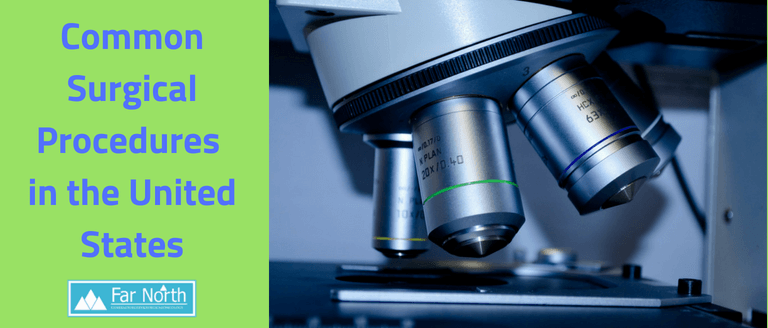There are two main types of surgical procedures that are performed in the United States, laparoscopic and traditional surgeries. The main difference between the two types is the amount of tissue that is damaged during the course of the procedure. Ask your doctor about each type of procedure so you fully understand what each procedure involves.
Here are several different types of surgical procedures that are commonly performed in the United States:
- Appendectomy – Removal of an infected appendix
- Breast biopsy – A biopsy is used to remove a small sampling of breast tissue cells to test for the presence of breast cancer
- Cataract surgery – Cataract surgery is performed to remove the cloudy lens that cover the eye and replace it with a clear one
- Cesarean section – A Cesarean section is performed to deliver a newborn baby if vaginal delivery is not possible
- Coronary artery bypass – A bypass procedure is performed to re-establish blood flow to the heart using veins (harvested from the leg or chest) and grafted into place to bypass the blockage
- D & C (Dilation and curettage) – A D & C is a minor procedure in which the uterine lining and cervical canal are scraped by a curette, removing any dead cells or debris
- Hemorrhoidectomy – A hemorrhoidectomy is performed to surgically remove both internal and external hemorrhoids
- Hernia repair – An inguinal hernia repair is a surgical procedure in which a mesh patch is placed over a perforation in the abdominal wall preventing the intestines or other organs from protruding through
- Hysterectomy - The removal of all or part of the female reproductive system, including the ovaries, Fallopian tubes, cervix, and uterus
- Hysteroscopy - This is a diagnostic procedure in which an instrument is inserted into the uterus to identify any intrauterine disorders
- Low lumbar surgery – Low lumbar surgery is used to repair damage to vertebrae and reduce the severity of many types of back pain
- Mastectomy – Mastectomies are surgical procedures that can involve removing all or part of the breast as a way of removing cancer. The procedure may also include possible reconstruction of the breast
- Partial colectomy - The removal of a small section of a diseased or cancerous large intestine or colon
- Prostatectomy – A prostatectomy involves removing all, or a portion of an enlarged or diseased prostate gland
- Tonsillectomy - Tonsillectomies are used to remove diseased tonsils and adenoids that are located at the back of the throat
Let’s check out some frequently asked questions about surgical procedures:
What is the difference between a traditional and laparoscopic surgery?
Laparoscopic surgical procedures involve the use of a small incision in either the abdomen (laparo-) or near a joint (arthro-). The doctor inserts surgical tools into the incisions and uses a small camera to perform the operation. This type of surgery reduces the amount of tissue affected by the procedure and dramatically speeds up the healing process. There is also a significant reduction in the risk of infection. Many doctors prefer this type of procedure because it reduces the amount of pain for the patient and patients tend to experience fewer complications after the surgery is over. Traditional surgery may involve making a long incision and completely opening the affected area. A Cesarean section is an excellent example of this type of procedure. These surgical procedures are often more extensive and require that the doctor have more room within the body to complete the procedure. Traditional surgeries often require an extended hospital stay due to the increased healing time and risk of infection. Doctors can also closely monitor the patient for any changes in their condition that may have been affected by the procedure.
What does a general surgical procedure include?
General surgery involves various surgical procedures that are used to treat a wide range of problems associated with the abdomen and other organs connected to it. These organs include the esophagus, small bowel, stomach, colon, gallbladder, liver, pancreas, bile ducts, appendix, and often the thyroid gland. They are also used to treat diseases that involve the skin, soft tissue, breast, trauma, and hernias. They also include peripheral vascular surgery and endoscopic procedures like colonoscopy and gastroscopy.
What is the difference between a major and minor surgery?
A major surgery involves an invasive surgical procedure where an extensive resection is performed while in a minor surgery, only connective tissue, skin or mucus membranes are resected. If you have any questions about a surgical procedure that you may have to undergo, make sure to speak directly with your physician. They can provide you with the answers you need to make an informed decision. You may have additional options available to you that could reduce your healing time and get you back on your feet much faster. Far North Surgery is one of the best surgery centers in Alaska providing world-class surgical procedures. Dr. Prasad and his team are committed to providing outstanding patient experiences in a caring and compassionate environment. He received the 2018
Best of Anchorage Award in the Cancer Treatment category by the Anchorage Award Program and qualifies for the Anchorage Business Hall of Fame.
Contact us to discuss your health issues.


